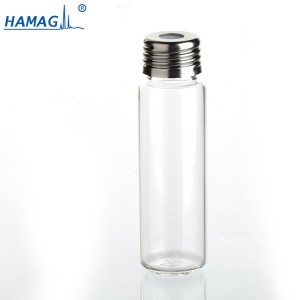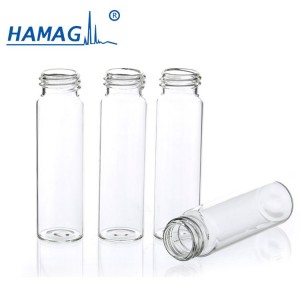-

Item Lab Use Storage Bottle Glass Vial Clear Amber Sampling with Cap
Description We have a variety of storage bottles to meet the different needs of the laboratory.. Specification Cat No Description Packaging HM-0505DD 0.6ml screw amber vial for micro storage φ15*35mm 100pcs/pack HM-0505K 0.5ml screw amber vial for micro storage empty bottom φ16*52mm 100pcs/pack HM-4465 Black screw solid top PP cap nature PTFE silicone septa 100pcs/pack HM-4465H Red screw solid top PP cap nature PTFE silicone septa 100pcs/pack ... -

18mm screw for GC GCMS instrument clear headspace vial metal caps
HAMAG offer vials screw neck 18mm 20ml clear headspace vial for GC GC/MS instrument with aluminum caps.
The spiral headspace series of bottle caps combines innovation with time-saving and convenience. It can avoid excessive evaporation and keep the sample bottle well sealed. The unique screw thread design ensures consistent sealing. The bottle neck is processed accurately and it is easy for mechanical arms to operate.
-

40mL TOC EPA Glass Vial Clear Bottle for water analysis instruments like Hach
HAMAG offer a range of certified Total Organic Carbon (TOC) vial kits which are suitable for use with all TOC manufacturer’s instruments.
Available in three configurations – all Certified to contain <10ppb Carbon
Silicon/PTFE septa plus integral dust cover for caps
Vials, caps and septa are subjected to the most rigorous cleaning to meet the U.S. EPA’s “Specification and Guidance for Contaminant-Free Sample Containers”, OSWER Directive 9240.0-05A, December 1992.
Each case of vials comes with a QC Certificate of Analysis (includes the Product Number and Lot Number bottle labels.
Representative Finished Good vials of each production lot are sent to independent, certified environmental laboratories for analysis using U.S. EPA Drinking Water Method 524.2 plus Fuel Oxygenates.

